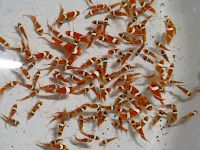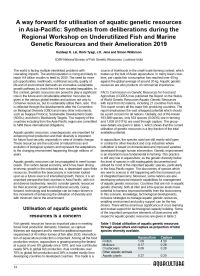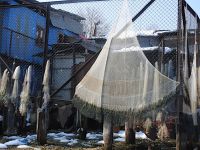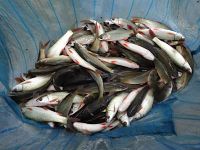Exploratory surveys conducted on pristine reef islands has revealed hidden diversity with discovery of two shrimp species new to science, Periclimenella agattii and Urocaridella arabianensis and range extensions for Thor hainanensis and Argeiopsis inhacae. A hands-on training in marine ornamental shrimp rearing was organised at Agatti Island, Lakshadweep during March 2020 to develop a core mass of entrepreneurs to participate in community aquaculture. Another initiative has established a live germplasm resource centre for clownfish, which has ten species conserved in captivity. This facility also serves as a master breeding facility to produce seed for use in a community aquaculture program.
Hypselobarbus pulchellus is endemic to the peninsular rivers of India, mainly the Krishna, Godavari, Tungabhadra, Sita and Tunga. It once formed a major fishery of the Tungabhadra reservoir but has declined to the status of a critically endangered species. H. pulchellus is a bentho-pelagic species which inhabits the deeper part of large streams and rivers along the base of ghats. It is the only indigenous fish that consumes aquatic weeds and submerged grasses, and could play a role in controlling aquatic vegetation in reservoirs, tanks and irrigation canals. Capable of attaining 8 kg, H. pulchellus would make a welcome addition to pond culture practices of India, especially for composite fish culture. This article gives an overview of the breeding and seed production technologies developed by ICAR-CIFA for farm-bred and pond-raised H. pulchelllus.
The Regional Workshop on Underutilized Fish and Marine Genetic Resources and their Amelioration organised by the Asia-Pacific Association of Agricultural Research Institutions (APAARI) was organised on July 10-12, 2019, in collaboration with the Sri Lanka Council of Agricultural Research and Policy (SLCARP) and National Aquatic Resources Agency (NARA) in Sri Lanka. About 95 participants from thirteen countries of Asia-Pacific region participated in the workshop. The perspectives gained will be instrumental in increasing awareness of the importance of underutilised aquatic genetic resources and to formulate strategies for strengthening their sustainable use at the regional level.
Kashmir Valley is bestowed with abundant water resources in the form of high altitude lakes, wetlands, rivers and springs and the geophysical conditions offer a great scope for fish to thrive. Around 15% of the population has fisheries as a principal source of income. In Kashmir, the dominant active fishing gear is the cast net, known locally as zaal, and cast nets are heavily used in the Dal, Wular, and Manasbal lakes of the valley. This article describes typical designs of cast nets used in the valley.
The ‘Moyna Model’ is accepted as an example for freshwater fish culture throughout West Bengal. Moyna is a great example of the freshwater fish culture revolution in West Bengal and a new horizon for culture of the major carps. Moyna fish farmers have adapted the procedures of Andhra farmers incorporating their own blend of experience, skill and technology. This article describes the history and development of major carp culture practices in Moyna, challenges faced by the industry including groundwater exploitation, and documents the experience of some progressive farmers.




